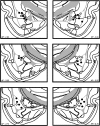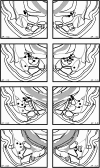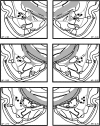The amygdala is not necessary for unconditioned stimulus inflation after Pavlovian fear conditioning in rats
- PMID: 19794190
- PMCID: PMC2769164
- DOI: 10.1101/lm.1531309
The amygdala is not necessary for unconditioned stimulus inflation after Pavlovian fear conditioning in rats
Abstract
The basolateral complex (BLA) and central nucleus (CEA) of the amygdala play critical roles in associative learning, including Pavlovian conditioning. However, the precise role for these structures in Pavlovian conditioning is not clear. Recent work in appetitive conditioning paradigms suggests that the amygdala, particularly the BLA, has an important role in representing the value of the unconditioned stimulus (US). It is not known whether the amygdala performs such a function in aversive paradigms, such as Pavlovian fear conditioning in rats. To address this issue, Experiments 1 and 2 used temporary pharmacological inactivation of the amygdala prior to a US inflation procedure to assess its role in revaluing shock USs after either overtraining (Experiment 1) or limited training (Experiment 2), respectively. Inactivation of the BLA or CEA during the inflation session did not affect subsequent increases in conditioned freezing observed to either the tone conditioned stimulus (CS) or the conditioning context in either experiment. In Experiment 3, NBQX infusions into the BLA impaired the acquisition of auditory fear conditioning with an inflation-magnitude US, indicating that the amygdala is required for associative learning with intense USs. Together, these results suggest that the amygdala is not required for revaluing an aversive US despite being required for the acquisition of fear to that US.
Figures






Similar articles
-
NMDA receptor antagonism in the basolateral but not central amygdala blocks the extinction of Pavlovian fear conditioning in rats.Eur J Neurosci. 2010 May;31(9):1664-70. doi: 10.1111/j.1460-9568.2010.07223.x. Eur J Neurosci. 2010. PMID: 20525079 Free PMC article.
-
Associative structure of fear memory after basolateral amygdala lesions in rats.Behav Neurosci. 2008 Dec;122(6):1284-94. doi: 10.1037/a0012903. Behav Neurosci. 2008. PMID: 19045948 Free PMC article.
-
The central nucleus of the amygdala is essential for acquiring and expressing conditional fear after overtraining.Learn Mem. 2007 Sep 6;14(9):634-44. doi: 10.1101/lm.607207. Print 2007 Sep. Learn Mem. 2007. PMID: 17848503 Free PMC article.
-
The amygdala: a potential player in timing CS-US intervals.Behav Processes. 2014 Jan;101:112-22. doi: 10.1016/j.beproc.2013.08.007. Epub 2013 Aug 22. Behav Processes. 2014. PMID: 23973708 Review.
-
The role of the basolateral amygdala and infralimbic cortex in (re)learning extinction.Psychopharmacology (Berl). 2019 Jan;236(1):303-312. doi: 10.1007/s00213-018-4957-x. Epub 2018 Jun 30. Psychopharmacology (Berl). 2019. PMID: 29959461 Review.
Cited by
-
Effects of muscarinic receptor antagonism in the basolateral amygdala on two-way active avoidance.Exp Brain Res. 2011 Mar;209(3):455-64. doi: 10.1007/s00221-011-2576-4. Epub 2011 Feb 12. Exp Brain Res. 2011. PMID: 21318348
-
Inactivation of the central but not the basolateral nucleus of the amygdala disrupts learning in response to overexpectation of reward.J Neurosci. 2010 Feb 24;30(8):2911-7. doi: 10.1523/JNEUROSCI.0054-10.2010. J Neurosci. 2010. PMID: 20181588 Free PMC article.
-
Re-valuing the amygdala.Curr Opin Neurobiol. 2010 Apr;20(2):221-30. doi: 10.1016/j.conb.2010.02.007. Epub 2010 Mar 17. Curr Opin Neurobiol. 2010. PMID: 20299204 Free PMC article. Review.
-
Chemogenetic Inhibition Reveals That Processing Relative But Not Absolute Threat Requires Basal Amygdala.J Neurosci. 2019 Oct 23;39(43):8510-8516. doi: 10.1523/JNEUROSCI.2530-18.2019. Epub 2019 Sep 6. J Neurosci. 2019. PMID: 31492771 Free PMC article.
-
Pavlovian Fear Conditioning Is More than You Think It Is.J Neurosci. 2023 Nov 29;43(48):8079-8087. doi: 10.1523/JNEUROSCI.0256-23.2023. J Neurosci. 2023. PMID: 38030400 Free PMC article.
References
-
- Balleine BW, Killcross S. Parallel incentive processing: An integrated view of amygdala function. Trends Neurosci. 2006;29:272–279. - PubMed
-
- Bandler R, Keay KA, Floyd N, Price J. Central circuits mediating patterned autonomic activity during active vs. passive emotional coping. Brain Res Bull. 2000a;53:95–104. - PubMed
-
- Bandler R, Price JL, Keay KA. Brain mediation of active and passive emotional coping. Prog Brain Res. 2000b;122:333–349. - PubMed
-
- Baxter MG, Bucci DJ, Holland PC, Gallagher M. Impairments in conditioned stimulus processing and conditioned responding after combined selective removal of hippocampal and neocortical cholinergic input. Behav Neurosci. 1999;113:486–495. - PubMed
Publication types
MeSH terms
Grants and funding
LinkOut - more resources
Full Text Sources
